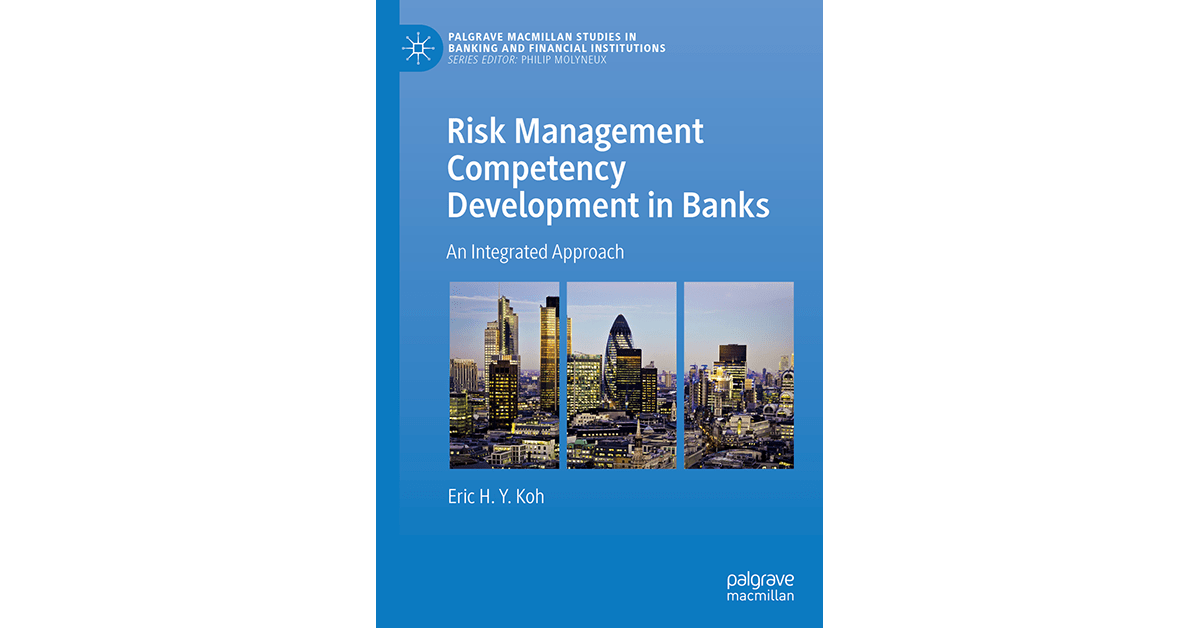[ad_1]
Risk Management Competency Development in Banks: An Integrated Approach. 2019. Eric H. Y. Koh. Palgrave Macmillan.
Risk management at banks — especially in a post-financial-crisis world — is a topic of critical importance to investors and regulators.
Eric H. Y. Koh, the author of Risk Management Competency Development in Banks, serves on the Faculty of Business & Accountancy in the department of finance and banking at the University of Malaya in Kuala Lumpur, Malaysia. He conducted interviews with 10 leading risk officers at Malaysian banks as part of his research for this book. Koh did so not only because he lives there but also because Malaysia’s “banks generally adopt global best practices in banking,” according to the World Bank and the International Monetary Fund (IMF) in 2013. Additionally, Malaysia is an emerging economy that is transforming into a high-income nation. The author himself considers the Malaysia-specific context and the small number of risk managers interviewed as possible limitations to his work, but in my view, they serve as a starting point for discussions of risk management with far broader implications.
Not only does well-executed risk management provide a sharp competitive advantage, but it also protects banks from regulatory fines. The author notes that in the 10 years subsequent to the financial crisis, the world’s banks paid more than $375 billion in fines for misconduct, including manipulating the reporting of the interbank rate, financing of money laundering, and securities fraud. Were such slips systematic failures arising from poor understanding of internal and external risk factors by management and staff or — more likely — the result of risk management oversight issues or the absence of an embedded risk management culture?
Here is the gist of the book, as presented in the abstract:
“Management weaknesses are key contributors to banks’ financial woes. Despite being a bank’s core competence, good risk management talent is scarce. One way of addressing this scarcity is to run the proposed integrated approach to competency development. This approach pools together three interrelated competency development concepts of core competency, dynamic competencies and the learning organization.”
The dynamic
competencies discussion seems forward looking, especially in light of the
emergence of new cryptocurrencies, such as Libra, and payment systems, such as
Venmo and Zelle. In the author’s view, the concept of core competencies focuses
on the continuous stretching of competencies and extending of the products
being offered, but it does not address the question of how a firm should build
its fundamental or baseline competencies. This aspect is covered in the dynamic
competencies concept, which focuses on how firms can successfully adapt to
external changes. Banks must stay on their risk management toes to face the
challenges associated with their products and services in the future. The
author deals clearly with such competitive, regulatory, and risk management
threats.
Koh elaborates imaginatively on learning organizations using soccer, gridiron football, and
badminton analogies. Prior to reading this discussion, I would not have
considered sports management analogous to risk management competency in banks.
Somehow, though, it works.
Many of us have our own definition of a “learning
organization.” The author defines it in a setting where people at all seniority
levels are motivated to develop their own mastery and work collaboratively by
exchanging views on the firm and external environment, continuously building
the firm’s competitive advantage. In this context, the author also highlights
the transfer of workers from specific disciplines, such as trading, to risk
management. Citing the example of Goldman Sachs using this strategy, he notes
the contribution of real-life perspectives on life in the trading room,
potential risks arising from trading, and the creation of mitigation plans that
may prove valuable if a trading crisis emerges.
The author pools these concepts together to form a more
potent approach to developing competencies comprehensively. He helpfully
identifies 23 operationalized indicators relevant to banks’ management function,
which he then reduces to 18 indicators by the end of this brief and accessible
book.
Risk Management
Competency Development in Banks does not contain a bibliography, but it
provides excellent references at the end of each chapter, highlighting such
sources as McKinsey & Company, the US Department of the Treasury, the IMF,
and the Journal of Banking & Finance,
among many others.
Despite the author’s own concern for his book’s shortcomings — notably, that he focuses on Malaysian banks and that he interviewed only 10 risk management officers — it should be required reading for those in leadership at banks, bank regulators, investors in banks, banking sector equity analysts, and investment bankers globally. It has broad implications that sector participants need to heed — in particular, concerning the competency and continuity of risk management development at all levels of professional experience in a bank, regardless of where it is domiciled, even including entrepreneurial institutions. One can visualize the implications of risk management competency development for other financial sector participants, such as insurers and brokers, as well.
If you liked this post, don’t forget to subscribe to the Enterprising Investor.
All posts are the opinion of the author. As such, they should not be construed as investment advice, nor do the opinions expressed necessarily reflect the views of CFA Institute or the author’s employer.
Professional Learning for CFA Institute Members
Select articles are eligible for Professional Learning (PL) credit. Record credits easily using the CFA Institute Members App, available on iOS and Android.
[ad_2]
Image and article originally from blogs.cfainstitute.org. Read the original article here.

